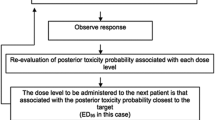Abstract
Background: Spinal hyperbaric ropivacaine may produce more predictable and reliable anesthesia than plain ropivacaine for cesarean section. The dose-response relation for spinal hyperbaric ropivacaine is undetermined. This double-blind, randomized, dose-response study determined the ED50 (50% effective dose) and ED95 (95% effective dose) of spinal hyperbaric ropivacaine for cesarean section anesthesia. Methods: Sixty parturients undergoing elective cesarean section delivery with use of combined spinal-epidural anesthesia were enrolled in this study. An epidural catheter was placed at the L1∼L2 vertebral interspace, then lumbar puncture was performed at the L3∼L4 vertebral interspace, and parturients were randomized to receive spinal hyperbaric ropivacaine in doses of 10.5 mg, 12 mg, 13.5 mg, or 15 mg in equal volumes of 3 ml. Sensory levels (pinprick) were assessed every 2.5 min until a T7 level was achieved and motor changes were assessed by modified Bromage Score. A dose was considered effective if an upper sensory level to pin prick of T7 or above was achieved and no intraoperative epidural supplement was required. ED50 and ED95 were determined with use of a logistic regression model. Results: ED50 (95% confidence interval) of spinal hyperbaric ropivacaine was determined to be 10.37 (5.23∼11.59) mg and ED95 (95% confidence interval) to be 15.39 (13.81∼23.59) mg. The maximum sensory block levels and the duration of motor block and the rate of hypotension, but not onset of anesthesia, were significantly related to the ropivacaine dose. Conclusion: The ED50 and ED95 of spinal hyperbaric ropivacaine for cesarean delivery under the conditions of this study were 10.37 mg and 15.39 mg, respectively. Ropivacaine is suitable for spinal anesthesia in cesarean delivery.
Similar content being viewed by others
References
Ben-David, B., Miller, G., Gavriel, R., Gurevitch, A., 2000. Low-dose bupivacaine-fentanyl spinal anesthesia for cesarean delivery. Reg. Anesth. Pain Med., 25(3):235–239. [doi:10.1016/S1098-7339(00)90004-X]
Celleno, D., Parpaglioni, R., Frigo, M.G., Barbati, G., 2005. Intrathecal levobupivacaine and ropivacaine for cesarean section. Minerva Anestesiol., 71:521–525.
Connolly, C., Wildsmith, J.A., 1998. Intrathecal drug spread. Can. J. Anaesth., 45:289–292.
Fassoulaki, A., Gatzou, V., Petropoulos, G., Siafaka, I., 2004. Spread of subarachnoid block, intraoperative local anaesthetic requirements and postoperative analgesic requirements in Caesarean section and total abdominal hysterectomy. Br. J. Anaesth., 93(5):678–682. [doi:10.1093/bja/aeh258]
Fettes, P.D., Hocking, G., Peterson, M.K., Luck, J.F., Wildsmith, J.A.W., 2005. Comparison of plain and hyperbaric solutions of ropivacaine for spinal anaesthesia. Br. J. Anaesth., 94(1):107–111. [doi:10.1093/bja/aei008]
Gautier, P., de Kock, M., Huberty, L., Demir, T., Izydorczic, M., Vanderick, B., 2003. Comparison of the effects of intrathecal ropivacaine, levobupivacaine, and bupivacaine for caesarean section. Br. J. Anaesth., 91(5):684–689. [doi:10.1093/bja/aeg251]
Ginosar, Y., Mirikatani, E., Drover, D.R., Cohen, S.E., Riley, E.T., 2004. ED50 and ED95 of intrathecal hyperbaric bupivacaine coadministered with opioids for cesarean delivery. Anesthesiology, 100:676–682. [doi:10.1097/00000542-200403000-00031]
Glosten, B., 2000. Anesthesia for Obstetrics. Anesthesia, 5th Ed. Churchill Livingstone, New York, p.2049.
Greene, N.M., 1985. Distribution of local anesthetic solutions within the subarachnoid space. Anesth. Analg., 64(7):715–730. [doi:10.1213/00000539-198507000-00012]
Kallio, H., Snall, E.V.T., Tuomas, C.A., Rosenberg, P.H., 2004. Comparison of hyperbaric and plain ropivacaine 15 mg in spinal anaesthesia for lower limb surgery. Br. J. Anaesth., 93(5):664–669. [doi:10.1093/bja/aeh257]
Kang, F.C., Tsai, Y.C., Chang, P.J., Chen, T.Y., 1998. Subarachnoid fentanyl with diluted small-dose bupivacaine for cesarean section delivery. Acta Anaesthesiol. Sin., 36:207–214.
Khaw, K.S., Ngan, K.W., Wong, E.L.Y., Liu, J.Y.W., Chung, R., 2001. Spinal ropivacaine for cesarean section: a dose-finding study. Anesthesiology, 95:1346–1350. [doi:10.1097/00000542-200112000-00011]
Khaw, K.S., Ngan Kee, W., Wong, M., Floria, N., Lee, A., 2002. Spinal ropivacaine for cesarean delivery: a comparison of hyperbaric and plain solutions. Anesth. Analg., 94:680–685. [doi:10.1097/00000539-200203000-00037]
Logan, M.R., McClure, J.H., Wildsmith, J.A.W., 1986. Plain bupivacaine an unpredictable spinal anaesthetic agent. Br. J. Anaesth., 58:292–296.
Pedersen, H., Santos, A.C., Steinberg, E.S., Schapiro, H.M., Harmon, T.W., Finster, M., 1989. Incidence of visceral pain during cesarean section: the effect of varying doses of spinal bupivacaine. Anesth. Analg., 69(1):46–49. [doi:10.1213/00000539-198907000-00009]
Reisner, L.S., Lin, D., 1999. Anesthesia for Cesarean Section, Obstetric Anesthesia: Principles and Practice, 2nd Ed. St. Louis, Mosby, p.475.
Whiteside, J.B., Burke, D., Wildsmith, J.A.W., 2001. Spinal anaesthesia with ropivacaine 5 mg/ml in glucose 10 mg/ml or 50 mg/ml. Br. J. Anaesth., 86(2):241–244. [doi:10.1093/bja/86.2.241]
Wong, J.O., Tan, T.D., Leung, P.O., 2003. Spinal anesthesia with two different dosages of 0.75% glucose-free ropivacaine: a comparison of efficacy and safety in Chinese parturients undergoing cesarean section. Acta Anaesthesiol. Sin., 41:131–138.
Author information
Authors and Affiliations
Rights and permissions
About this article
Cite this article
Chen, Xz., Chen, H., Lou, Af. et al. Dose-response study of spinal hyperbaric ropivacaine for cesarean section. J. Zhejiang Univ. - Sci. B 7, 992–997 (2006). https://doi.org/10.1631/jzus.2006.B0992
Received:
Accepted:
Issue Date:
DOI: https://doi.org/10.1631/jzus.2006.B0992
Key words
- Anesthesia
- Obstetric
- Cesarean section
- Anesthetics local
- Ropivacaine
- Anesthetic techniques
- Subarachnoid
- Dose-response




